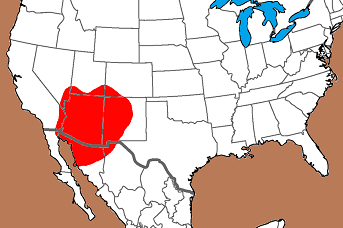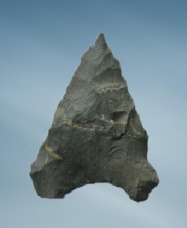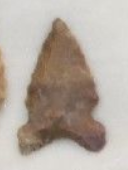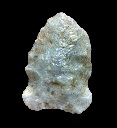Other Websites with Detailed Information:
Name Details:
Named By: Noel Justice
Named For: Type Site
Date Identified: 2002
Type Site: Ventana Cave, Arizona
Ventana Side Notch
AKA: Leupp Side Notch (Arizona, Michael Rondeau, 1979)
Chiricahua redefined
Cluster: Northern Side Notch Cluster
Commonly Utilized Material:
Basalt, obsidian, and chert
Date:
Cultural Period:
5,500 - 3,800 B.P.
Middle to Late Archaic
Middle Holocene to
Neoglacial
Glacial Period:
Culture:
Outline is Representative of Size and Shape:
Description of Physical Characteristics and Flaking Pattern:
This is a small to medium side notch point with an elliptical cross section. The blade may vary from excurvate to straight. The shoulders are commonly at an upward angle and may be weak on heavily
re-sharpened examples. The stem is expanding with a concave base giving the appearance of drooping ears. The stem is commonly wider than the base. This point has a random flaking pattern.
Size Measurements: Total Length - 20 to 75+ mm
(average 20 to 25 mm. Exhausted examples may be significantly
shorter), Stem Length - 6 to 15 mm, Blade Width - 12
to 22 mm (17 t 18 mm), Neck Width - 9 to 18 mm, Basal Width - 11
to 22 mm, Thickness - 4 to 8 mm
Distribution:
Distribution Comments:
This point is primarily found in the southwest and southern Colorado Plateau
and into southern Arizona and southwestern New Mexico and into northern
Sonora, Mexico.

Similar Points:
Abiquiu, Chiricahua, Diablo Corner Notch, Frio, Northern Side Notch, Paisano, Pasitas, San Rafael, Sudden Shelter, San Jose Tehuacan, Tlanalapa, Todsen Related / Associated Points:
Additional Comments:
These points were originally called Leupp Side Notch by Michael Rondeau (1979) for examples found at Kahorsho Site in Arizona. Many collector type publications refer to this type as Squaw Mountain.
The Ventana distribution overlaps the distribution of the San Rachael distribution, except that the San Rafael distribution is more concentrated in the northern Colorado Plateau and the Rocky Mountains where the
Ventana has the highest concentrations in the southwest and southern Colorado Plateau (Justice, 2002).
Justice (2002) feels that this the Chiricahaua point has been poorly defined
and the described characteristics of this type overlay the San Jose point.
He feels that this has led to confusion of this point and that the point
needs to be re-defined in order to reduce confusion. He has renamed
the Chiricahua point the Ventana Side Notch.
Point Validity: Valid Type
Justice is a distinguished
anthropologist and Assistant Director and Curator of Collections at Glenn A. Black Laboratory of Archaeology at Indiana University. This point was named in his book on
points of the Southwest. This type has many professional references. This is considered a valid type.
.
Age Details:
References: (See Reference Page, Entry Number):
23, 30, 39, 189
Ventana Side Notch Projectile Point, Ventana Side Notch Arrowhead




.jpg)
